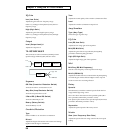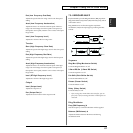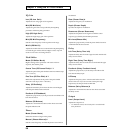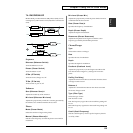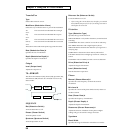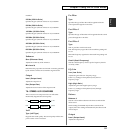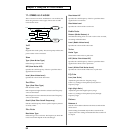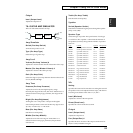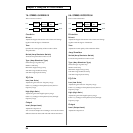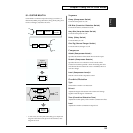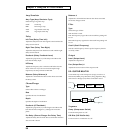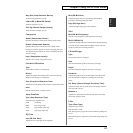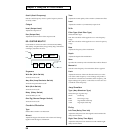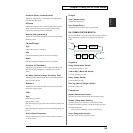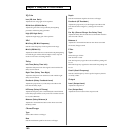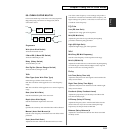
94
Chapter 2 Using the XV-5080 Effects
79: STEREO OVERDRIVE
This is a stereo overdrive.
fig.02-079m.e
Overdrive
Drive #
Adjusts the degree of distortion. The volume will change
together with the degree of distortion.
Tone
Specifies the sound quality of the Overdrive effect.
Amp Simulator
Switch (Amp Simulator Switch)
Turns the Amp Simulator switch on/off.
Type (Amp Simulator Type)
Selects the type of guitar amp.
SMALL: small amp
BUILT-IN: single-unit type amp
2-STACK: large double stack amp
3-STACK: large triple stack amp
EQ Gain
Low (Low Gain)
Adjusts the gain of the low frequency range.
Positive (+) settings will emphasize (boost) the low-
frequency range.
High (High Gain)
Adjusts the gain of the high frequency range.
Positive (+) settings will emphasize (boost) the high-
frequency range.
Output
Level (Output Level)
Adjusts the output level.
You can use the Output Level setting to even out the volume
difference between the sound with and without Overdrive.
80: STEREO DISTORTION
This is a stereo distortion.
fig.02-080m.e
Distortion
Drive #
Adjusts the degree of distortion. The volume will change
together with the degree of distortion.
Tone
Adjusts the sound quality of the Distortion effect.
Amp Simulator
Switch (Amp Simulator Switch)
Turns the Amp Simulator switch on/off.
Type (Amp Simulator Type)
Selects the type of guitar amp.
SMALL: small amp
BUILT-IN: single-unit type amp
2-STACK: large double stack amp
3-STACK: large triple stack amp
EQ Gain
Low (Low Gain)
Adjusts the gain of the low frequency range.
Positive (+) settings will emphasize (boost) the low-
frequency range.
High (High Gain)
Adjusts the gain of the high frequency range.
Positive (+) settings will emphasize (boost) the high-
frequency range.
Output
Level (Output Level)
Adjusts the output level.
fig.02-080ms.e
L in
R in
L out
R out
Amp
Simulator
2-Band
EQ
Overdrive
Amp
Simulator
2-Band
EQ
Overdrive
L in
R in
L out
R out
Amp
Simulator
2-Band
EQ
Distortion
Amp
Simulator
2-Band
EQ
Distortion



